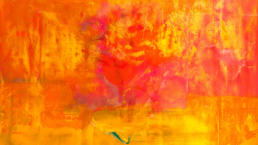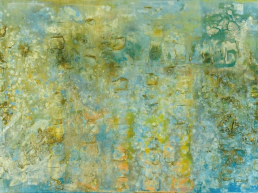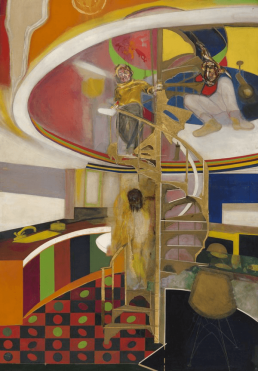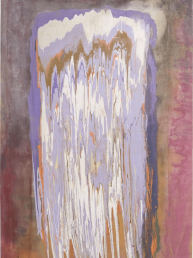
“There was a discussion among artists of how to get the materials to deliver all the expectations and emotions and truth and clarity. And I realised – Boom! This is it. It’s about the material, not some sort of story. Gradually I decided to erase, say, the image of my mother and replace it with shape, colour and structure.” - Frank Bowling
Artland’s Lost (and Found) Artist Series focuses on artists who were originally omitted from the mainstream art canon or largely invisible for most of their career. This week, we feature Frank Bowling, an artist born in what was then British Guiana (now Guyana) who studied art in London and lives and works between London and New York. Bowling’s first major retrospective was on view at Tate Britain through 26 August 2019. The show spanned the entirety of Bowling’s career, bringing together a lifetime of Bowling’s large-scale works. However, it took decades for the now 85-year-old artist to gain widespread recognition in the UK – as a black artist painting in an Abstract Expressionist style in the 1960s, he spent many years on the sideline.
Frank Bowling’s Beginnings in Art
When 19-year-old Frank Bowling arrived in Britain in 1953, he planned on becoming a poet. But after meeting the artist Keith Critchlow during his national service in the RAF, he soon became encouraged to switch directions and focus on visual arts. Bowling studied at the Chelsea School of Art, and then at the Royal College of Art. Initially, the RCA rejected him due to lack of experience in drawing from life, but fortunately the RCA’s head of painting Carel Weight recognised Bowling’s talent and accepted him and funded his studies. At the RCA, Bowling studied alongside figures like David Hockney, Patrick Caulfield, RB Kitaj, Derek Boshier, Allen Jones and Pauline Boty – in other words, some of the stars of British pop and other modern art. Bowling’s style at the time was inspired by pop, but had something expressionist in it, with hints of Francis Bacon, who was a friend of his at the time.
The year he graduated, in 1962, Bowling had his first solo show, but after this things slowed down for him in London. Many of his paintings from the 1960s were so undervalued that they have since vanished. He was also overlooked in the important survey show “The New Generation: 1964” which was held at the Whitechapel Gallery. Then, in 1966, he was selected to represent Britain at the World Festival of Negro Arts in Senegal, and he had enough. He felt his blackness was used to tone down Britain’s colonial history, and protested that he was being seen as a black artist, rather than simply as an artist. He felt that Britain saw him as an outsider, and decided to leave for New York.
Bowling’s life between London and New York, as well as the difficulty in defining exactly what a Frank Bowling painting looks like, could be contributing factors to the fact that Bowling has remained far less well known than many of his RCA peers.
Frank Bowling in New York
It was 1966 when Bowling moved to New York. There, he became acquainted with the world of Abstract Expressionism and the colour field painters. When he first moved to New York he was still working with some figuration, adding images of family members and childhood memories to his paintings. But an ongoing discussion among artists in the US about how to get the materials to deliver the message, the emotions and truth and clarity, hit home with Bowling. He realised this was the road he needed to take – it was about the material, rather than the story. With this in mind, he gradually began to erase the images of his relatives and started replacing them with shapes, colours and structure.
Back in London at the RCA, he had been warned not to experiment with abstraction or he might face expulsion. In New York, he went all out and began laying large canvases on the floor and making increasingly abstract paintings. One series he did came to be known as his “Map Paintings” – stenciled maps of Africa, South America and Australia covered with washes of colour. A little later, he started experimenting with “Poured Paintings” – pouring paint from a height onto the canvas.
In New York, Bowling was successful. He had a solo show at the Whitney Museum of American Art in 1971, but returned to London in 1975 to be with his family. And though he kept studios in both cities from that point onwards, there was another challenging issue – the fact that he started working in the Abstract Expressionist style just as it was on its way out of fashion. The postmodernists were adamantly dismissing it as macho, arrogant, and at times even imperialist and Conceptual and Minimal art were on the rise as countermovements. But for Bowling, it offered a way to portray his personal history and the history of slavery and colonialism through colours, textures and materials.



Bowling’s Formalism and Civil Rights
While Bowling was in New York, the civil rights movement was experiencing a heated peak, and black artists were often expected and pressured to use their art to serve the cause. Black abstract artists had it hard: they were often placed below their white peers and not taken as seriously, while black civil rights activists, people from their own community, criticised them for not actively painting subjects related to the civil rights movement. Bowling, however, described himself as a “Formalist”. He was concerned with how the materials of a painting and their use could engage the emotions. He believed paint’s possibilities should be at the core of a black aesthetic in art, rather than social commentary. At the time, Bowling wrote several essays in which he defended black abstract artists, and insisted that they were artists first, and should not be pigeonholed only as black artists.
Return to England and The Great Thames Series
Bowling’s return to England was marked by a more confident and fluid style. In the late 1980s, he created his Great Thames series, suggesting both Monet’s luscious water lilies and Turner’s mysterious and ethereal coastal scenes. Still, Bowling had a particular style and method of his own, adding different materials and textures to his colour-filled canvases to evoke the movement, life and depth of the river. Objects included in his canvases might be things one could find by the riverbanks of the Thames.
In 1988, everyone in London seemed to be focused on the Young British Artists – it was the year of Damien Hirst’s exhibition Freeze. But here was Bowling, creating his stunning, large abstract canvases of the Thames with material ranging from paint to acrylic gel, foam and found objects. His was a road not frequently trodden in that time and place, but this never deterred him from continuing in this style.

“I’m looking for something that will jolt me and I can feel that rush – the nervous system being so excited it’s going to act. It’s what keeps me awake at night.” - Frank Bowling
Into the Works of Frank Bowling
Mirror (1964-66)
Mirror is a work which contains a selection of styles which Bowling was exposed to at the time of painting it in 1964-66. There are elements of American colour field painting, pop art, and figures reminiscent of Bacon. Here, Bowling attempted to connect different aspects of his life and to catch the things that were happening in the world at the time. At the centre of the painting is the spiral staircase of the RCA. Bowling is featured twice, once at the top, once at the bottom of the staircase. His wife at the time is featured in the middle. Their marriage ended when the painting was completed – the Eames chair in the painting most likely refers to the affair between designer Charles Eames and Bowling’s wife.

Map Paintings
Bowling started creating his Map Paintings (1967-71) after moving to New York in 1966. They feature continental landmasses spray-painted with stencils, and mark an evolution in Bowling’s pictorial language. Here, he attempts to combine abstract painting with his political and personal concerns. The Map Paintings refer to postcolonialism and the artist’s own Afro-Caribbean roots while following Bowling’s desire to explore abstraction as far as he could. In the words of curator Okwui Enwezor: “By staking a ground around the idea that abstraction need not be disunited from content, especially as it intersects cultural experience and historical subject matter, Bowling boldly experimented with diverse modes of building a painted surface.”
Middle Passage is one such Map Painting, a monumental canvas of nearly three metres square. It deals with the theme of slavery, and refers to the journey across the Atlantic which Africans were forced to make as slaves in the 18th and 19th centuries. Bowling represents the immense suffering through colour – yellows, oranges and reds blast out over the green of the ocean.

Poured Paintings
Bowling began experimenting with pouring paint onto canvases around 1973. In doing so, he produced layered effects of contrasting colours. With these poured paintings, Bowling responded in his own way to the challenges of formalism in modernist paintings, which suggested that the visual aspects of artworks were more important than the content. Bowling built a tilting platform in his New York and London studios, which allowed him to pour paint from high up. These works reveal Bowling’s interest in the tension between a structured approach to painting and accidental developments.

Recent Work
Today, the 85-year-old artist can no longer paint completely alone. He needs help applying paint to canvas, and usually sits in the middle of the room while directing his grandson Frederik with a laser pointer. Frederik explains that he is like an extension of Bowling’s paintbrush.
For the past decade or so, Bowling has been interested in revisiting collage and relief techniques that he worked with before. He combines them with pouring, staining, stencilling, cutting, and stitching canvases. Bowling still comes to his studio every day, continuing his search for something that will jolt him awake and give him that excited rush that he knows and loves so well.
Frank Bowling is represented by Hales Gallery in London, Marc Selwyn Fine Art in Los Angeles, and Alexander Gray Associates in New York.
